This weekend was a very interesting one for those of us who study the Martial Art Choi Kwang Do as it was the 25th Anniversary festival and seminar. (I have written, and talked a lot about how I arrived at CKD via technology, as in the Flush The Fashion Article but as with all journeys there are always new discoveries). People from all over the globe arrived and took part in a variety of activities. Most notable was the presence of the founder of CKD Grand Master Choi.
He presented several times to various groups of us. At the age of 71 he is still incredibly flexible, physically fit and sharp of mind. Not to mention blindingly fast with his techniques.
Whilst I have been considering (as have others in CKD) the use of technology to aid training and perfecting of the techniques we use it struck me just how important our human biology is in the whole art. The way we learn, how we train, our motivations for training all need to be looked at.
That is obvious at one level, you can’t have a martial art of blocking, punching and kicking without humans. It can seem from the outside, as with many martial arts that the formality and structure is making everyone the same. Uniformity being an apparent goal. This is not the case though as I heard many times that everything has to be relative to the individual.
During the seminar we got to meet Jordan Leiva who has been practicing CKD for a long time, but who clearly also likes to use tech to improve and analyse and share his movements. To see the precision of years of practice in slow motion even if you are not part of a martial art is very poetic.
CKD is often described as being based on scientific principles but as I heard explained a few times in various ways the science has almost followed what was a gut feeling that Grand Master Choi had with a maverick view of doing things a better way. This is probably the other reason I gravitated towards this tribe of people. If the founder is a bit of a maverick, challenging the way things are done it it a natural fit.
Clearly the science of biomechanics feature a lot in being able to move and defend oneself from any attack, but it seems that the mere fact of learning the sequences, slowly and without pressure or tension offer range of other benefits to the brain and systems around it, with the ability to also ramp up the same patterns and moves to achieve different physiological effects. So how will technology help us adjust and train things going on inside our minds and bodies? I am still looking at kinect for the motion of the body, but I think I need to roll in the Neuorsky and alike to deal with mental state too.
I had always looked at exercise as something that was pretty binary. You put a lot of effort in, or you were not doing it right. I was aware that different heart rates altered the effect of exercise but still that seemed a very mechanical. Seeing the ease with which experts and Masters in CKD performed their patterns, and hearing Grand Master Choi point out that over training was not a good thing started to put my attitude to us as human pieces of technology in a different light.
A quick google to start to look at a bit of the brain science and the chemical changes we cause ourselves, which ties in with some of the anecdotal pieces of information I got to hear this weekend. This paper (though many academic papers are locked behind a paywall). It would appear there are some great chemical balancing acts that excercise causes. All related to BDNF (Brain-Derived Neurotrophic Factor). Physical activity at the right level for the age and abilities of the person increases brain function and grows new neurons. However too much and it damages the ability to learn. So you can reach a tired state, just at the right level for you as and individual and then be more receptive to new information.
I have been interested for a long time in people’s motivations and why they engage with certain tasks, games etc. How something feels is as important as what something is.
I think as we blend ourselves more with technology we are all going to have to start understanding the deeper impact it may have on our physiology which means there is a lot more room for a Cyber Martial Art that CKD could become aiming at improving all our experiences of life. It is another exciting avenue to investigate, whilst also not trying to over analyse and just enjoy the journey.
ckd
Rez Day again – Reflection on 7 years of joy and pain
All the joys of trying to move physical home and my focus on training in Choi Kwang Do, plus the Predlets being on holiday meant my Rez Day in Second Life nearly passed me by! It has been just over 7 years now since diving into SL and that has been a catalyst for a great number of changes and opportunities (and quote a few threats) in my life and the lives of many of my friends and colleagues.
I am still amazed at the power of what happened back in 2006 the power of people to gather and share in a virtual space. The creativity and buzz is something that many of us will never fully experience again.
This may seem crazy but this formed part of a customer briefing on security!

We really didn’t know the potential(which is still there), we just knew that exploring code and shapes, interactions with people etc was going to take us somewhere. I mean what do you do when your scripted space hopper rolls away into someone else space?
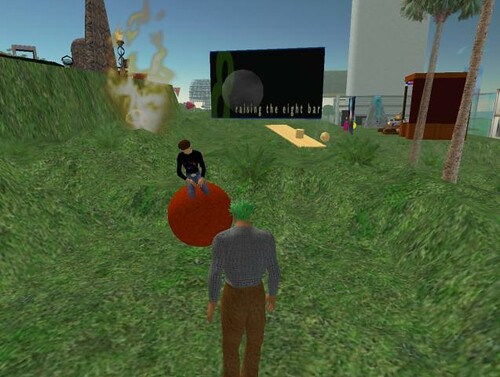
There are not many pieces of software that you can look back on and say that of. Of course the software, the networks etc was just an enabler for people to communicate and explore.
I have a collection photos of real events that happened in world. These are as memorable to me as any other photo or holiday snap. Real people doing real things, just mediated through bits and bytes.
I am still amazed though at the fear and negative vibes that many of us endured, and in some cases still do from the actions we took online with one another. It is hard to see why, when something is actually so positive it needs people to act against it. Not act against Second Life but against the freeform organisation of others. I doubt anyone who as experienced this will ever be able to fully share the full details of their particular lows. Many are deeply personal. Those acting to destroy such a positive wave of energy know full well what they were doing, who knows they may think they have won some fairground prize. In reality they have lost something and probably strengthened something and in a way done us all a favour.
What do we take as a positive from that though? Well anything that generates that much passion, both for and against it is not just another fad, another niche. It is obviously tqping into some deep needs in humans to either communicate and share, to gather together, or on the other side of the virtual coin to control and break things that they do not understand.
Unfortunately as it was the people not the software that was the problem, it was the people’s potential that got attacked not the bits and bytes.
2006-2009 was a technology bubble for virtual worlds, it was also a cultural bubble. We had to go through that and experience the joy and pain of it all in order to be here for the next wave. Culture takes a while to change but we are seeing much more sharing, much more open source. A realisation the power is in people not organisational structures. You can have a balance. You can have rank, a meritocracy. You can have rules but yet creative freedom within them.
What happened for a small portion of us in Virtual Worlds back then called eightbar was that we all worked to improve our own understanding of what the potential was, but in doing that we wanted to help others who were on the same journey. It was not about money or power. It was not about glory or control. That is hard for many people to understand who were not feeling the buzz.
I am now able to reflect on what we did instinctively for the good of the art so to speak but seeing how the martial art I study works. This does not feel a tenuous link as the conversations we have resonate with 7 years ago for me.
A martial art is a meritocracy. Through your personal goals and willingness to better yourself at your own level your earn belts. In Choi Kwang Do this is not through beating people or competing. It is not through negative comments of how badly you are doing, how much you missed a target. Instead it is active encouragement to enjoy mistakes to evolve and reach a goal. Lining up in belt rank order is never to say those with the higher belt are better. They are more experienced but they still learn, they still add to their skills. This is where it may lose some people though. We have control. A person, usually with lots of experience, will run a session. They will give commands, set tasks. We do them. It may seem regimented, yet each person is aiming to improve their technique, to learn and evolve. The person in charge at the time is also improving their own knowledge through observation, helping others with positive pointers. People step up to lead and are allowed to lead because they have earned the respect of everyone. However they never, ever apply any ego to that.
If I was to head back to 2006 and the wave of awesome virtual world discoveries, the teamwork and the sense of adventure we all had I am pretty sure I would do it all again. For me now, having seen another very positive gathering of humans trying to explore something exciting, yet applying some structure, I may have been able to help us be something a little stronger to deal with those less enlightened individuals. Maybe even to help them achieve more. The martial art is focussed on defence against a threatening force though. With out the potential for threats, without a counter to all this positivity it would not need to exist. So maybe we just enjoyed such a productive and interesting time because were were up against some people who were not so interesting or productive 🙂
This year I still did some work in Second Life too. I was part of a build of a hospital experience that was about dealing with a mass influx of patients. The doctors and hospital staff (real ones) had to decide which patient to move where to make space for the sudden influx. There was a lot of code I had to design and put in place to be able to make patients deteriorate, take time to move from one place to another. Deal with multiple decisions, provide visual feedback etc. We did all this in order to help lock down the requirements. Then went on to build a web based version networked with voice too in Unity3d. We have then used it to inspire some kids too, we even added a few friendly dancing zombies. Kids love zombies. It is a fine line between playing and being serious. Virtual worlds and games bounce across that line, twist it, warp it and sometimes rub it out all together. Still they can be used for so many reasons and why wouldn’t you?
Making animation easier with QUMARION
I tweeted about this the other, but after it came up in the Q&A session at yesterdays blended reality pitch I realized I had not put any more here about this interesting device.
The QUMARION is rather like the posable wooden mannequins that artist use to practice drawing figures

It is instead fully instrumented with sensors to work with a digital description of a human skeleton.
So as you pose the figure that translates to poses in the 3d modelling package.
A purist 3d designer may regard that as undermining their skills with manipulating and understanding the interface on a 2d screen. However this came up as an answer to a question about blended reality as I was talking about how sometime the technology can get in teh way, other times it disappears and lets us use what to know to enhance an experience.
The QMARION is rather like using the real guitar in Rocksmith, it may be an appropriate tool for understanding and communicating with an application.
I know that when I use 3d packages there is a barrier in having to deal with a mental translation of a 2d representation. Being able to just pose a physical device and explain what is needed physically would work for me.
A long while ago I was trying to make some tennis animations for a well known Second Life project. I found myself standing and looking in a mirror, performing the action then sitting down making that action work on a very simple digital rig, but then I had to tune it so that it looked better for the screen. I had no motion capture which would obviously have helped in the first place, but it is the extra artistic interpretation and subtle tweaks that it would have helped a great deal to have had a hands on device to help.
Now this device is only input as far as I know so there is an obvious extension in using it as an output device too. If I mocap a move, but then the device can play that back in physical steps and frames then I could tweak and enhance it. Obviously in games there are some moves that just don’t exist, you cant get certain flips and jumps happening. You can however start with a basis of what you can do.
Again of course this relates to studying the forms in Choi Kwang Do. A physical, but digitally recorded recreation may help someone even more to understand. Also a mannequin can be made to hold a position that may be a transfer on one move to another that a person bound by the law of physics cannot. It becomes a physical pause button.
Another extension to the idea is that this restricts you to one rig. A component model that lets you build any size or shape of joints to create the armature for any creation would be incredible. Combine that with the ability to 3d print the components in the first place, but them together, have that create the rigged model and then animate away. There are some fantastic opportunities for people to create interesting things as this approach evolves.
Blended Reality Learning
Tonight at Southampton Solent University, room HC021 on the ground floor of the Herbert Collins Building, SO14 0RD at 6:30 I will be given a BCS Animation and Games Development presentation that is a further extension/summary to some of the things i have recently written about in how the physical interaction with virtual environments make for a perfect blend to learn new things and take on information.
I just posted the pitch, minus the videos (which I replaced with stills) on slideshare.
The main content is really about how this blended reality is starting to emerge. With things like Skylanders as toys, but also devices interacting with games environments. At the same time the evolution of playing guitar from plastic pick to Rocksmith and finally the journey that I have described in Flush and here about how I got into the martial art Choi Kwang Do inadvertently via using the kinect to try and get fit and how I see the inklings of a future that improves learning and communication for all of us. As usual a lot of chatting with pictures, but the gist is in the slides.
Virtual Athletes – A journey with some tech
It was really cool today to see the brilliant next edition of Flush Magazine hitting the virtual shelves (with my 3rd article). This time on some of the virtual sports technology and a little bit of historical evolution from my personal experience. There are lots of other things to read in the mag, also available on the ipad, but my contribution is pages 92 to 97.
There are lots of ways to check this out including a great PDF download
So thats virtual sports, merged with real activity and my newly found and exciting Choi Kwang Do martial art and the Coaches Center in this issue. The previous issues have been 3d printing and virtual worlds 🙂
Huge thanks go out to @tweetthefashion for publishing these articles and the monumental effort it is for them to get the whole edition done, making them look so good and with everyones great stories and features 🙂
The power of the mind, flow – Martial Arts
With my increasing, though long term interest in technology related to sport I was very interested to see this article by the Wellcome Trust about brain scans revealing the clues to black belt punching power.
There is of course a lot to be discovered about how we work as humans. Self belief we already know is very powerful and can drive people to achieve things other may consider impossible. That self belief in Martial arts could be down to fine tuning and practice of techniques. This article points to a change in brain structure as certain skills are perfected. To my non neuroscience trained eye that makes a lot of sense.
However the excellent video (inserted below) goes further to make the links between mind and body. It describes the self development aspects of martial arts. “A martial art is not a sport, if practiced properly its a way of life”
As is said in the video you can know thousands of techniques, be big and strong and be defeated in an instant by your mind.
My Choi Kwang Do journey is still in its very early stages but I have already felt surprise at what can be achieved, both watching the predlets and also myself.
Something that is very important is experiencing flow, being in the moment and operating without having to do any conscious mental processing. For some people that is one of the hardest parts of the journey, to let go. I am by no means an expert in flow, but I have experienced it a lot, coding, presenting and particularly in gaming. Tackling a tricky section of a game where you get more and more wound up, the more tense you are the harder it is to perform. Sometimes brute force aggression gets you through as that bring adrenalin but inevitably a more calm, flow based approach will bring more success. It is something I am trying to teach the predlets through gaming as the results and the pay off are very obvious.
Being able to induce flow is the best mental state for interesting ideas and inventions to surface. Many people get flashes of inspiration when they are doing something other than trying to get a flash of inspiration.
It may be that out there in the workplace and in schools and colleges that the solution to helping people both stay fit and healthy and have a keen brain that comes up with good ideas and is not afraid to go with them may be enhanced by many of the martial arts. In particular those that are arts not sports like Choi Kwang Do (other martial arts are available).
A bit of SL fun then onto real CKD Virtual World Coaching
It has been a while since I just went for a wander in Second Life. I have very little building space on my islands now as they are pretty much totally rented out so I just have 1 corner or Hursley. So I thought as I was in there I would pop off and have a look around. It always helps to have a subject or a reason or something to search for, but I started off just looking at some art.

Though it then dawned on me I had not explored martial arts in Second Life for a very long while and I thought I would take a look with my new Choi Kwang Do enabled brain. (enabled by SouthCoast CKD 🙂 )
There are a fair few martial arts related places, groups etc. None specific to CKD though. I did check out an arena for more kung fu and weapon related battles at Colibri.

Then I thought it was time the CKD logo made its way into SL and so my little plot now has the start of a virtual Dojang.
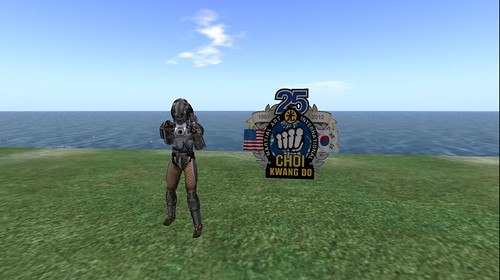
I popped along to Abraminations, just like in the old days back on ’06 (is it really that long ago!) and checked out the fighting systems and animations. The closest was a kickboxing one.
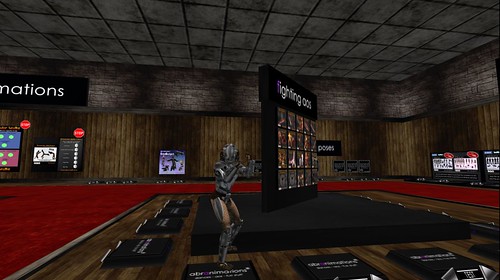
Then I shot this little video to see how off the animations are from CKD. The guard hand and stance and a lot of the moves are not as flowing as CKD but it shows an interesting potential to people not yet versed in virtual world tech and sports.
Now I am wondering about taking the kinect tracking and seeing if I can mocap that to my patterns for CKD and get the BVH file up into SL. Just so I could use a lot of acronyms 🙂 I know the skeleton format is going to be different but it is something to work on.
This is initially just a bit of fun, but…. as we know with projects like The Coaches Center we are getting closer to being able to enable hold gathering and meetings and share more insights.
Here I am sat in my personal coaches office, with Choi Terms on the board and a synchronized version of the kinect ckd test playing, the same view anyone would get if I invited them in.
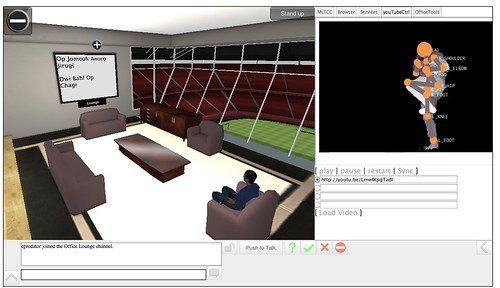
(You can also load videos and graphics etc onto various other boards in the room to share with people)
So there I am with a virtual presence, a shared space and all the tools available voice, text, imagery, avatar placement reaching out to the web to pull in other content. All in Unity3d 🙂 check is out and register in the beta at The Coaches Center
Cool isn’t it? Imagine being able to attend a class from anywhere for those time when you just can’t get to the Dojang, or for blackbelts and masters all over the world to connect and share their insights.
More Choi Kwang Do kinect tests
Having tried using a relatively complex set up for the previous text of kinect on the Mac specifically for enhancing or viewing Choi Kwang Do moves I came across a much richer way to visual it. This uses the Tryplex created set of macros in the Quartz Composer on the Mac.
Oddly I had not come across the incredibly powerful and useful Quartz composer sat here on my machine!
It allows structured linking of macros and rendering to create motion graphics and sound.
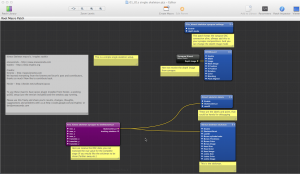
The Tryplex toolkit has a lot of examples of how to process skeleton information and render it. It comes in two flavours. One is the more complicated to set up OpenNI/Nite/OSCSkeleton as the input for the data. i.e. the setup I had previously for the simple viewer. Or it uses a quicker to run app requiring no setup called Synapse. Despite having the other pieces set up I just used the synapse app for this one.
You simply copy a few macro files into the quartz libraries, run synapse to start the kinect and then run the Quartz simple skeleton.
This requires a cactus stance for calibration, unlike my previous uncalibrated example. Then away it goes.
I am by now means a reference pattern for the Choi moves, but I did try a yellow belt pattern and also a yellow senior speed drill, plus a few others. I also threw in some mistakes like punching from the front foot not the rear to see how easy it is to spot them.(I also tried a music replace with youtube, tongue in cheek 🙂 )
I have to say I was impressed! There are a whole load of other coded demos that show acceleration on a particular body part, or a very cool one involving shaping and moving a cube as a gesture object.
Now I have to figure out how to write Quartz macros, just another tech language 🙂
It also looks like a great way to combine the inputs from something like the BPMPro with the Kinect that I mentioned yesterday
Roll on tonight and another session at South Coast CKD to keep learning and on the journey
Run Makie Run
Firstly this is not related to anything official to do with any major sports event, so no brand police actions thank you very much.
The other day I blogged about using some homebrew kit to make martial arts related monitoring. It is an ongoing side project, but as part of that I mentioned using the Blobo for some of it as it has a motion sensor. Well in the course of thinking that through I wondered if I might be able to do something a little quirky to bring my Makie alive.
With the hollow head in the Makie designed for an arduino lily pad I thought I would see what happened if I put the Blobo in as the brain. I mean a 3 axis bluetooth transmitting fully functioning device seems like a good idea and saves a lot of soldering 🙂
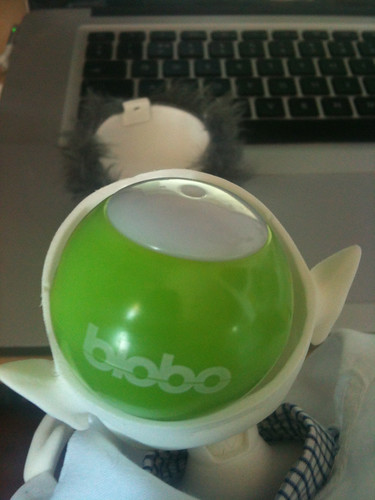
The Blobo nearly fitted in the head. Without the eyes in it is the right size as is.
However much of the Blobo is designed to give it a decent size and feel, so with the guts ripped out it looks a much better fit.

So here he is going for a “run” with the Blobo sprinting app.
I have the SDK kindly provided by Martin Gossling at Quarternion so I can write some more Makie specific Unity3d applications. So if you pick up the Makie or move him at all he will be able to respond.
Trying this project out led Martin to get in touch re the Choi Kwang Do requirements and in a wonderful bout of serendipity they have repackaged and upgraded some of the same principles of the Blobo into BPMPro which looks like a great thing for CKD practitioners to give a go so watch this space as this looks very exciting 🙂 I think that combined with Kinect to some brilliant insights and ways to fine tune technique (not just power an speed) will evolve.
So this has merged the threads of 3d printing with Makie, homebrew use of technology for things other than it was intended (Maker Culture), the modern martial art of Choi Kwang Do and some Unity3d. Funny little ideas need to be explored as they are often lynch pin to a wider goal. “Feeding edge: Taking a bite out of technology so you don’t have to” 🙂
Technology and Martial Arts
After a great Hampshire Choi Kwang Do festival I have been pondering ways to use some of the readily available technology to help support the teaching of CKD.
CKD is a modern martial art and one that is not set in stone but evolves. Whilst I have only been learning (with predlet 2.0) for the past 6 months I have been impressed with the art’s flexibility.
At the festival we saw some technology to help measure and observe. All professional kit but I wondered what could be done in a maker style at home.
The first thing was to work out if I could build something to measure contact force or pressure. I was looking through my box of bits for the Arduino but then googled and found things like this. The pieces of foam that chips are delivered pushed into have an interesting property that when pressed their electrical resistance changes. They become pressure sensors. I got a small square of foam, put tin foil on either side of it, jammed multimeter probes into it and sure enough when you push on the foam the resistance drops. So next is to make a bit more robust connection, attach it to the arduino and see what happens with the foam gets punched rather than pressed.
The other thing I wanted to check was if the Kinect open source modules would respond quickly enough. I did a quick test using SensorKinect/OpenNI/NITE and it seemed to work. There is a way to go to be able to make sure that we can track the subtle elements of the movements but it will certainly help with some of the angles and stance positions.
I also have a cunning plan with the Blobo if I can get the dev kit to try it out but as it is a 3 way accelerometer with bluetooth connectivity to be able to count hits.
